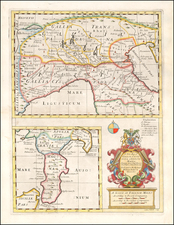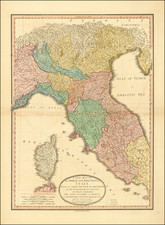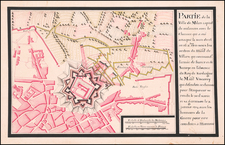This rare engraved bird's-eye view of Turin provides a contemporary depiction of the siege of Turin in 1640, illustrated by A. Parentani and engraved by G.P. Bianchi. It showcases the city and its surroundings during a pivotal moment in the Franco-Spanish War, part of the Thirty Years' War, with an attached text providing titles and legends.
Turin, in the 17th century, was a focal point of European political and military conflicts. The 1640 siege, depicted in this map, occurred during the regency of Duchess Maria Cristina of Savoy, following the death of Duke Vittorio Amedeo I. This period was marked by internal strife within the House of Savoy, as Maria Cristina's rule was challenged by her brothers-in-law, Princes Tommaso and Maurizio. The map, therefore, not only represents the city's topography but also a critical juncture in its history, where the balance of power within the Savoyard state was fiercely contested.
The careful attention of Parentani and Bianchi is evident in the detailed rendering of Turin's streets, fortifications, and surrounding landscape. Notably, this is the first map to include the city's expansion towards Porta Nuova, indicating a significant urban development amidst the backdrop of war. The bird's-eye perspective offers a comprehensive view of the city's defensive structures and the areas impacted by the siege, making it a valuable resource for understanding 17th-century military architecture and urban planning.
Its depiction of Turin during a tumultuous era serves as a tangible link to the past, providing insights into the city's evolving landscape and the broader geopolitical dynamics of the time. This print stands as a testament to the rich historical tapestry of Turin, offering a unique window into its heritage and the complexities of European politics in the 17th century.










![[ Grand Duchy of Tuscany ] Dominio Fiorentino](https://storage.googleapis.com/raremaps/img/small/98624.jpg)
![[Venice] Murano aux Venitiens [on sheet with:] Fort de Malamoco](https://storage.googleapis.com/raremaps/img/small/92316.jpg)

![[Manuscript cadastral map of the area of Strevi in the Province of Alessandria, in Piedmont, Italy]](https://storage.googleapis.com/raremaps/img/small/57262.jpg)
